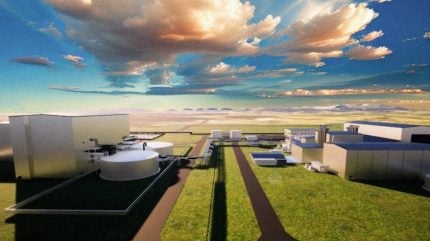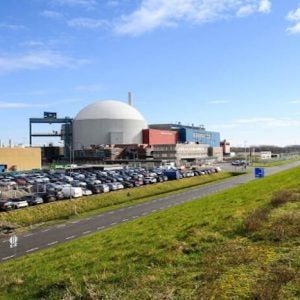
US-based nuclear technology company TerraPower has awarded contracts to three more suppliers for its Natrium Reactor Demonstration Project. TerraPower said these awards complete the procurement selection for long lead items for its Natrium Reactor Demonstration Project under construction in Kemmerer, Wyoming.
The Natrium technology features a 345 MWe sodium-cooled fast reactor with a molten salt-based energy storage system. The Natrium demonstration project is being constructed near a retiring coal facility in Wyoming. Non-nuclear construction on the project began in June 2024.
“TerraPower is the first company making major procurement selections for the next generation of nuclear power,” said Chris Levesque, TerraPower President & CEO. “Today’s awards, in addition to all the procurements awarded over the last 18 months, align us with experienced suppliers who are committed to bringing the first Natrium reactor and energy storage system to market.”
The awards include:
- James Fisher Technologies (JFT), headquartered in Loveland, Colorado. JFT will design and fabricate the Sodium Cover Gas (SCG) and Test and Fill Facility (TFF) Filter Skids. The SCG and TFF Filter skids are comprised of special application equipment in addition to standard components used within radioactive gas processing systems in the nuclear industry. The primary functions of the filter skids are to house and support vapour traps, caesium and various aerosol filters and to align and isolate gas streams in the appropriate exhaust systems.
- Mirion Technologies headquartered in Atlanta, Georgia. Mirion will supply the Radiation Monitoring System (RMS) and the Nuclear Instrumentation System (XIS). The RMS comprises area, effluent and process radiation monitors that monitor plant radiation levels. XIS provides instrumentation and detection of reactor power levels.
- Curtiss-Wright headquartered in North Carolina. Curtiss-Wright has been selected for two awards; to design and deliver the Training Simulator (TSN) and to supply the Distributed Control Systems (DCS) for the Natrium reactor. The TSN is a full-scope simulator that will replicate plant equipment and accurately simulate system conditions and operations to support operator training and licensing. It will be housed in the Kemmerer Training Centre. The DCS is a digital platform that serves as a core component for automating control and operation of plant processes. Curtiss-Wright will develop two separate control systems for the plant: the Nuclear Island Control system (NIC) and Energy Island Control system (EIC).
In October 2024, TerraPower awarded Idaho-based Premier Technology a contract for the design, testing, fabrication and delivery equipment for the Natrium Reactor Demonstration Project. The equipment includes the sodium-air heat exchanger (AHX) and the air stack structures and equipment (ASE). These components are part of the intermediate air cooling (IAC) system.
In June 2024, TerraPower executives, including Chairman Bill Gates, took part in the groundbreaking ceremony for the planned Natrium reactor facility in Kemmerer. Along with PacifiCorp and GE Hitachi Nuclear Energy, members of the demonstration project team include engineering and construction partner Bechtel, Energy Northwest, Duke Energy and nearly a dozen additional companies, universities and national laboratory partners.
The demonstration plant, planned for Kemmerer, is intended to validate the design, construction, and operational features of the Natrium technology. However, in December 2022, TerraPower postponed the expected start date of the reactor by at least of two years. The company had originally hoped to commission the plant in 2028 using Russian-supplied high-assay low-enriched uranium (HALEU) fuel but the conflict in Ukraine, however, made continuing Russian HALEU deliveries uncertain and the projected commissioning date is now 2030.
The US Nuclear Regulatory Commission (NRC) in May 2024 accepted TerraPower’s construction permit application for review, marking the first time in more than 40 years that the NRC has docketed this type of application for a commercial non-light water reactor. In his blog, Gates said he expects the NRC review process to take a couple of years. “So in the meantime, TerraPower will continue to build the non-nuclear parts of the facility”. Construction will begin next year on the so-called “energy island,” which is where the steam turbines and other machinery that actually generate power will sit. (The reactor will eventually be part of a “nuclear island,” and the team hopes to start building that in 2026.)”
However, while the TerraPower website provides some details of work done with molten salt, it contains very little information about the reactor technology. It is also notable that none of the contracts signed with suppliers relate to the reactor itself.
Basically, the Natrium reactor is a sodium-cooled fast reactor. Currently, the only commercially operating liquid metal-cooled fast reactors are in Russia, using sodium as the coolant. Development of these reactors took decades supported by full government support. In the US and Europe research on fast reactors took place in the 1960s and 1970s. However, interest waned as concerns about scarce uranium resources lessened and public opinion became increasingly hostile to nuclear in the wake of the 1979 Three Mile Island accident in the USA and the Chernobyl disaster in 1986.
By the early 1990s the US, the UK and Germany had closed down their programmes. France continued with projects for a few more years, finally closing Superphénix in 1998 and Phénix in 2009, In 2019, France also cancelled the Generation IV ASTRID sodium-cooled fast reactor demonstrator design project. Although interest is now reviving in Europe and the USA, it remains at the early design phase and is probably decades away from implementation.
As an example, India’s prototype sodium-cooled fast breeder reactor began fuel loading in March 2024. The Indira Gandhi Centre for Atomic Research (IGCAR) began to design the reactor in 1980 and construction only began in 2004, 24 years later. Technical and financial problems then caused further delays.






